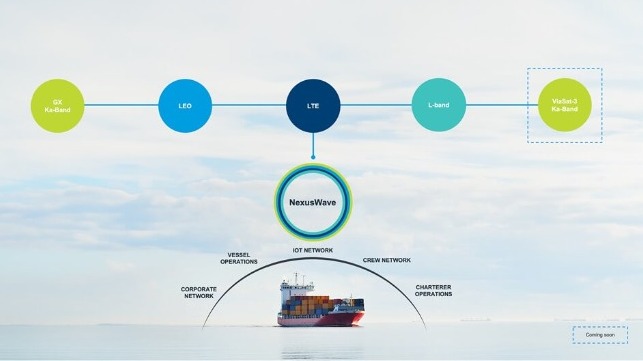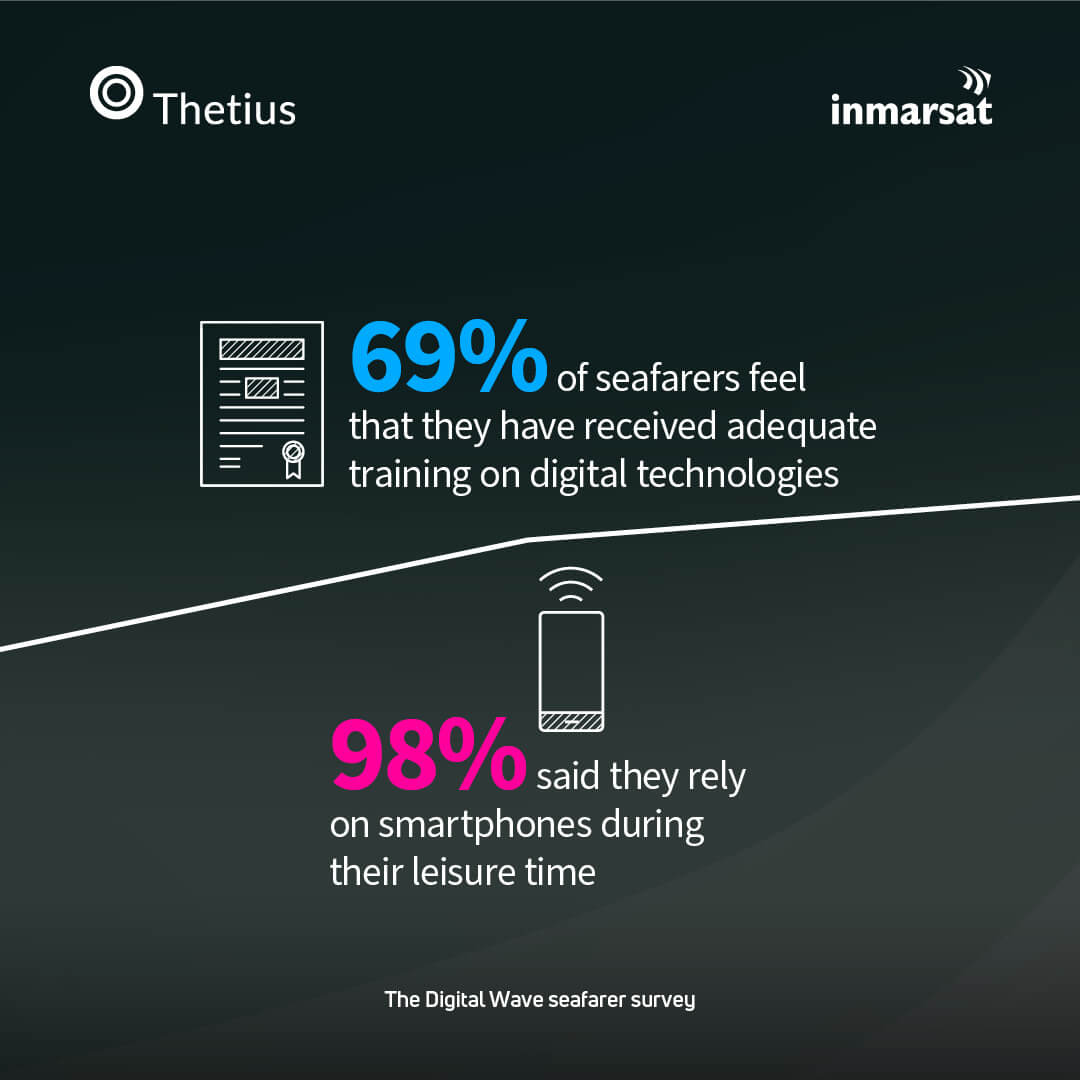Life Aboard the Floating Office: The Seafarer's Perspective

Seafarers’ increasing dependence on digital technologies for both work and leisure highlights the need for onboard connectivity that is fast, reliable, and ‘always on’, says Inmarsat report ‘The Digital Wave’.
Published by Inmarsat Maritime, a Viasat business, The Digital Wave: Transforming vessels into floating offices and remote homes examines how crews and shore-based teams are using digital technologies today – and the connectivity they rely on during work and leisure time.
Of the approximately 100 seafarers surveyed for the report, 88% have access to the Internet for work and leisure, while 12% have Internet access solely for work purposes. On average, the respondents reported spending five hours a day using digital tools to complete work-related tasks.
The research indicates that crew on deck are increasingly using smart ship technologies to optimize route planning and manage energy consumption. According to the Thetius IQ Intelligence database, the implementation of artificial intelligence (AI) systems at sea is also on the rise. AI systems enhance situational awareness to help seafarers detect targets and make timely collision-avoidance decisions. By reducing the navigational burden on the crew, they can also minimize fatigue-induced errors.
In the engineering department, AI is the foundation for the condition monitoring and predictive maintenance systems that allow personnel to proactively schedule and execute services, thereby cutting downtime and costs. Thanks to the combination of video conferencing with virtual reality (VR) and augmented reality (AR), onboard engineers can also connect with shore-based support staff to receive live and accurate troubleshooting assistance.
In addition, AR- and VR-based simulation has revolutionized seafarer training by enabling the crew to gain hands-on experience with a system, process, or piece of equipment from the safety of a classroom.

Connectivity for the remote home
With the maritime industry becoming ever-more reliant on digital technologies to support safe and efficient operations, the connectivity needs of many vessels today are comparable to those of small and medium-sized businesses – and ships are increasingly regarded as ‘floating offices’. However, since a vessel is not only a place of work but also a ‘remote home’ for seafarers, onboard connectivity is required during leisure as well as work hours.
In 2022, in a major breakthrough for seafarer welfare, amendments to the Maritime Labour Convention 2006 made crew connectivity a regulatory requirement. Yet even before then, the provision of high-speed onboard Internet access had established itself as a competitive differentiator among ship owners.
During Inmarsat’s 2023 ‘Connected Future’ seminar, Ron Welles, C-Comm Manager, Edison Chouest Offshore, discussed a fuel resupply mission to Antarctica in 2021 in which crew internet proved pivotal.
According to Welles, Edison Chouest was informed it would be unable to hire seafarers for the mission unless it could provide them with the facility to keep in touch with their families. In response, the company turned to Inmarsat for onboard connectivity. “Two-and-a-half years later, it’s one of the most successful jobs that we’ve done in that part of the world,” commented Welles. “If you don’t provide the crew with a means to [connect with family], you’ll have a difficult time in today’s world.”
The importance of enabling crew to maintain contact with loved ones is reflected in the report’s survey results, which found that 80% of respondents primarily use their free time on board to communicate with friends and family. Meanwhile, 70% use their leisure time to browse the Internet, 64% to make and receive video calls, and 54% to watch films – all activities that rely on stable, high-speed connectivity.
In a follow-up question about the impact of slow connectivity or Internet outages, respondents referred to “stress and anxiety”, the inability to take “proper rest”, “loneliness and fatigue”, “mental trauma”, “depression”, and a lack of focus during work hours. A reliable connection helps seafarers to avoid these problems not only by allowing them to talk to friends and relatives and unwind but also by connecting them to trained healthcare professionals through mental health hotlines and telemedicine services.
High speeds, unlimited data, and global coverage
Given the bandwidth required to support the systems and services used above and below deck – and the potential consequences of a lagging or unstable connection on safety, efficiency, and crew well-being – ship owners are increasingly seeking fast, reliable, and ‘always-on’ connectivity.
Inmarsat’s newly launched fully managed service, NexusWave, integrates multiple high-speed networks in real time – Global Xpress Ka-band, low-Earth orbit services, and as-available coastal LTE – with an additional layer of resilient L-band. Delivered by a single provider as a unified solution, it offers complete transparency on total cost of ownership, meaning vessels are reliably and securely connected to high-speed Internet – with no unexpected charges.
As a result, customers’ ships are transformed into seamlessly connected, high-performing floating offices and remote homes – with benefits for operational safety and efficiency as well as crew welfare.
“It’s clear that seafarers today require digital technologies as much to unwind in their free time as they do to perform their jobs effectively,” said Marco Cristoforo Camporeale, VP Strategy & Business Development, Inmarsat Maritime. “By delivering high-speed connectivity, unlimited data, and global coverage in one package, NexusWave keeps vessels and crews connected around the clock, wherever they are sailing, to help ensure safe, efficient operations and a happy and motivated workforce.”
The opinions expressed herein are the author's and not necessarily those of The Maritime Executive.
